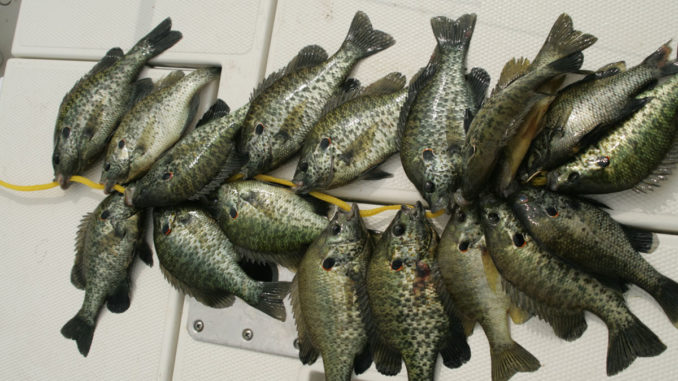
Crappie, catfish move out for summer comfort
Summer patterns have settled in on the Santee Cooper lakes, and that’s not a bad situation. When the water heats up and the sun bears down, some species will get into very reliable patterns in deeper water.
Two favorites gone deep are crappie and catfish. Largemouth bass can still be caught shallow, although they will often be found tight to cover. Good bream fishing will be found around weed or tree cover in the 3- to 5-foot depth range, but catching limits of fish will usually require more effort and covering water compared to previous months of good bed-fishing action. Also, fishermen will score well fishing at night for catfish and crappie.
Guide Buster Rush said July is a prime time for slab crappie on both lakes.
“Both lakes are excellent for crappie during July; I focus most of my attention on Lake Marion,” he said. “Lake Moultrie produces excellent crappie action using the same techniques; typically, the bite is just in deeper water. Tight-lining minnows over deep brush or cover such as the public fish attractors can produce excellent results on big crappie in both lakes.”
Rush (803-432-5010) said a fisherman’s strategy must change from shallow-water thinking to catch crappie in July.
“Now that the spawn and shallow-water fishing is over, we can count on most crappie orienting to brush,” Rush said. “In Lake Marion, we’ll find a lot of fish in the 12- to 16-foot depth range, usually at the top of the brush or woody cover. Often, the water may be about 20 feet deep or even slightly deeper on the bottom where we fish, but the brush will usually stick up several feet. Near the top of the brush and around the edge is where I find most of my crappie.
“I use tight-line rigs and minnows as bait; however, an experienced angler using jigs will be able to score well vertically jigging or even casting small jigs and working them around the cover,” Rush said. “This is a strong and productive pattern for most of the summer, and the biggest issue is usually the heat.
“July is a good time to catch a limit of quality fish on either lake. A fisherman does not have to be on the lake at dawn to be successful, although that’s my preference so I can beat the heat. But once the sun gets up a bit, the crappie often tend to orient even tighter to the cover, making them easier to find and catch later in the morning. The temperature may be hotter, but sometimes, the fishing is hotter.”
Some anglers beat the heat and catch limits of crappie by fishing at night using lights. The lights attract bugs, forage and, of course, crappie, along with perch and catfish. Most crappie fishermen anchor in 20 to 30 feet of water in Lake Moultrie and slightly shallower in Lake Marion, but often, the fish will be caught in the 10- to 20-foot depth range. Usually, the fish will not be caught right on the bottom when fishing at night under the lights. Also, both the white and green lights have popular followings among local anglers, and both seem to produce good numbers of fish, so there does not seem to be a favored light color at Santee Cooper.
Catfish action is also excellent in July, and Rush fishes for catfish on Lake Marion throughout the summer and fall. He said there are areas on Lake Marion that can be drift-fished, and that is productive at times, but he usually anchors because of all of the underwater snags in the areas he prefers.
“The entire summer is great for catfishing, and I’ll often fish early mornings or late afternoon, or even at night, particularly if I’m trying to catch big flatheads,” he said. “I’ll use live bait for flatheads, but most of my effort will be focused on the more abundant blue catfish, so typically, cut bait will be my bait of choice for the most action. I will mix the baits to determine a good pattern on any given day. I’ll fish the edges of drops and humps and sometimes into the deeper holes looking for big fish. I rely on my graph to help me pinpoint not only big fish, but forage in the area as well.”
Fishermen can still catch plenty of largemouth bass in both lakes, and most big fish are still shallow, although slightly deeper than during the spring. Low-light times are still best for more-aggressive fish, and topwater lures such as buzzbaits and frogs fished around the edge of cover are lethal. Bottom-bumping lures typically rule during the day in slightly deeper water. It’s not unusual to find several bass in a small, general area, so most bass experts suggest moving and fishing until you catch a couple of good fish, then work that area hard.
Bream and shellcracker will still be caught on both lakes throughout July, but they are typically bunched up in specific areas. Some bedding can occur on the July moon, but greatly reduced from previous months in May and June. July is more of a hunt-and-peck fishery for bream. Use red worms to target shellcrackers in the area around the Diversion Canal, which can be excellent during hot weather. Crickets are best for bream and work around the cypress trees, logs, stumps and weedy cover. When you find fish, work that area thoroughly. Bream tend to congregate in a localized area when the habitat and water is right. It’s not bed-fishing as much as bream clustered in a general area. Fish the area hard until the action slows, then repeat the process. Catching a limit of big panfish is a very reasonable goal if you move and hunt for them.





Be the first to comment